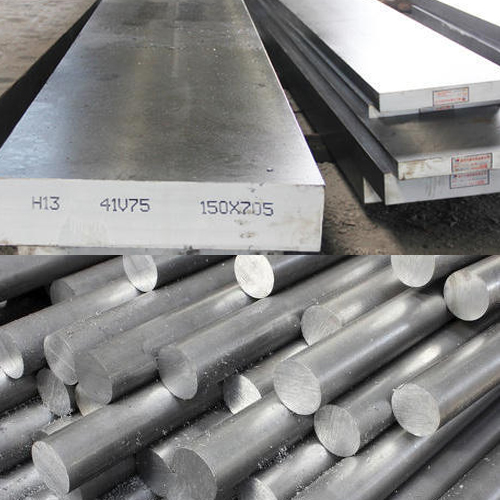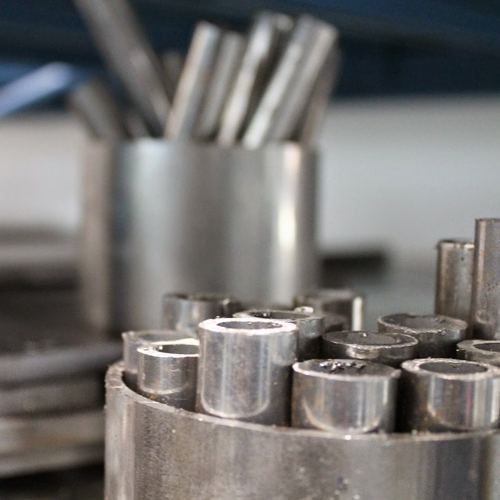Die Steel And Tool Steel
These Die Steel and Tool Steel grades can get in a form of Round Bar, Flat, Square, and also in Plate and Sheet.
Die Steel EN31
Die Steel Round Bar is a high carbon Alloy steel that achieves a high degree of hardness with compressive strength and abrasion resistance.
Die Steel D2
D2 steel is an air-hardening, high-carbon, high-chromium tool steel. It has high wear and abrasion-resistant properties. It is heat treatable and will offer a hardness in the range of 55-62 HRC, and is machinable in the annealed condition. D2 steel shows little distortion on correct hardening. D2 steel’s high chromium content gives it mild corrosion-resisting properties in the hardened condition. Cold-work tool steels include the high-carbon, high-chromium steels or group D steels. These steels are designated as group D steels and consist of D2, D3, D4, D5, and D7 steels. These steels contain 1.5 to 2.35% of carbon and 12% of chromium. Except for type D3 steel, all the other group D steels include 1% Mo and are air hardened. Type D3 steel is oil-quenched; though small sections can be gas quenched after austenitization using a vacuum.
Die Steel D3
Cold-work tool steels which include D2, D3, D4, D5, and D7 steels are high-carbon, high-chromium steels. Apart from D3 steel all group D steels have 1% Mo and are air hardened. Type D3 steel is oil-quenched; though small sections can be gas quenched after austenitization using a vacuum. As a result, tools made with type D3 steel tend to be brittle during hardening. Type D2 steel is the most commonly used steel among the group D steels. The D3 steels contain 1.5 to 2.35% of carbon and 12% of chromium.
Die Steel CW1
Cold work tool steels are employed for the manufacture of tools for applications involving surface temperatures below 200°C.In this temperature range, the steel must feature the following properties in order to guarantee tool resistance to the high stresses arising from the numerous machining and shaping.
Die Steel HCHCR
Thread rolling dies, Hobs, Cold extrusion tools and dies, Punches, Draw plates and dies, Cutters, Measuring tools, Pressure casting molds, Blanking, Reamer, Finishing rolls for tyre mills. This type of steel has high dimensional stability with added wear resistance coupled with excellent edge holding qualities.
Die Steel OHNS
Blanking and stamping die, Punches, Rotary shear blades, Thread cutting tools, Milling cutters, Reamers, Measuring tools, Gauging tools, Woodworking tools, Broaches, Chasers. An ideal type of oil-hardened steel that is economical and dependable for gauging, cutting, and blanking tools as well as can be relied on for hardness and good cutting performance.O1 Tool Steel is an electric-furnace melted, oil-hardened, non-shrinking, general-purpose tool steel. It is chemically composed of approximately 0.95 percent carbon, 1.1 percent manganese, 0.6 percent chromium, 0.6 percent tungsten, and 0.1 percent vanadium. The hardening temperature of O1 tool steel is between 790 degrees Celsius and 820 degrees Celsius.
Die Steel H13
Chromium hot-work tool steels are designated as group H steels according to the AISI classification system. This series of steels start from H1 to H19. The most commonly used chromium hot-work steels are H11, H12, and H13, which can be air-hardened in 150 mm thick sections. The steels are subjected to minimal distortion during hardening due to their balanced alloy content. The tools produced from chromium hot-work steels can be cooled using water without damage as these steels have low carbon and alloy contents.
Die Steel H11
Chromium hot-work tool steels are designated as group H steels according to the AISI classification system. This series of steels start from H1 to H19. The most commonly used chromium hot-work steels are H11, H12, and H13, which can be air-hardened in 150 mm thick sections. The steels are subjected to minimal distortion during hardening due to their balanced alloy content. The tools produced from chromium hot-work steels can be cooled using water without damage as these steels have low carbon and alloy contents.



